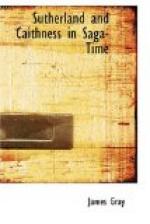They came to us not only from Norway direct, westwards across the sea. They came to us also from Normandy northwards through England. The first swarms of Norsemen had brought with them rapine and disorder. Later on the Norman came to the north to curb such evils, and to organise, administer, and rule the land. The Normans succeeded in this as signally as the Saxon barons, introduced under Saint Margaret, Malcolm Canmore’s Saxon queen, had failed. David I was by education a Norman knight. At heart he was an ecclesiastic. As Scotland’s king, he was, in theory, owner of Scotland’s soil from the Tweed to the Pentland Firth, and he disposed of it to his feudal barons, mainly Norman, and to religious foundations on Norman lines, as the Norman kings of England had done there before him, in order to organise and consolidate his kingdom; and his successors did the same.
Thus, as Professor Hume Brown puts it—[22]
“Directly and indirectly the Norman conquest influenced Scotland only less profoundly than England itself. In the case of Scotland it was less immediate and obtrusive, but in its totality it is a fact of the first importance in the national history.”
It affected Scotland in the latter part of the times which we have considered right up to John o’ Groats. Moray was divided among Normans and “trustworthy natives,” and the scattering of its Pictish population gave the Mackays to Sutherland, and, largely blended with the Norse, they still occupy the greater part of it. The Freskyns, as “trustworthy natives,” were introduced into Sutherland, after many a fight for it, by charter doubtless in Norman form; and Normans won Caithness in the persons of the earlier Cheynes and Oliphants and St. Clairs, who, by inter-marriage with the descendants in the female line of a branch of the Freskyns, possessed themselves not only of the lands of the family of Moddan but of most of the mainland territories of the Erlend line, through Johanna of Strathnaver’s daughters and great-grand-daughters.
At a time and in an age when liberty meant licence, the order which the Norman introduced into the north made more truly for real liberty and the supremacy of law, than the individual independence which the Norseman had left his native land to preserve; and though both feudalism and the blind obedience to authority then enjoined by the Catholic Church are no longer approved or required, and have long been rightly discarded, yet they served their purpose in their day, by evolving from the wild blend of Gaels and Norsemen, which held the land, a civilised people free from many of the worse, and endowed with many of the better qualities of either race.
NOTES
The following abbreviations are used:
H.B. for Hume Brown’s History of Scotland.
O.S. for Orkneyinga Saga.
O.P. for Origines Parochiales.
F.B. for Flatey Book.




